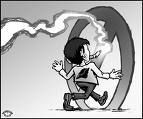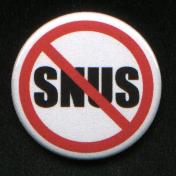Bringing the World of Tobacco Control closer together..
Camel by R.J. Reynolds Tobacco has a new
Minnesota would ban smoking in bars, restaurants and other establishments under a bill approved by the Legislature.
 May 12, 2007 - Minnesota would ban smoking in bars, restaurants and other establishments under a bill approved by the Legislature.The bill passed the state House by an 81-48 vote early Saturday, hours after the state Senate approved it 43-21. It now heads to Gov. Tim Pawlenty, who has said he will sign it. Minnesota would become the 20th state to prohibit smoking in bars and restaurants. Violations would carry fines of up to $300 for smokers and business owners who allow smoking. The ban would start Oct. 1, 2007. Supporters of the bill hailed its passage as a win for public health. Minnesota broke ground nationally in 1975 with the Clean Indoor Air Act, which limited smoking to designated areas in public places and at public meetings. (Minnesota Lawmakers Pass Smoking Ban by Martiga Lohn, apnews)
May 12, 2007 - Minnesota would ban smoking in bars, restaurants and other establishments under a bill approved by the Legislature.The bill passed the state House by an 81-48 vote early Saturday, hours after the state Senate approved it 43-21. It now heads to Gov. Tim Pawlenty, who has said he will sign it. Minnesota would become the 20th state to prohibit smoking in bars and restaurants. Violations would carry fines of up to $300 for smokers and business owners who allow smoking. The ban would start Oct. 1, 2007. Supporters of the bill hailed its passage as a win for public health. Minnesota broke ground nationally in 1975 with the Clean Indoor Air Act, which limited smoking to designated areas in public places and at public meetings. (Minnesota Lawmakers Pass Smoking Ban by Martiga Lohn, apnews) Congratulations to the Great State of Indiana.
 May 11, 2007 - On February 27, 2007 the SNUS Newsbrief read "Shame on Indiana" for rejecting Gov. Mitch Daniels' proposal to increase cigarette taxes. Governor Mitch Daniels on Thursday (5/10/2007) signed into law legislation that will help provide health insurance to uninsured Hoosiers. The measure will increase the cigarette tax by $0.44 per pack (to a $1/pack) in order to fund several new initiatives, including a healthcare plan for low-income residents, funding for small businesses to offer health benefits, childhood immunizations and smoking cessation programs. The new coverage will begin January 1, 2008. The plan is estimated to discourage 40,000 fewer youth smokers and 23,400 fewer adult smokers. Thirty-three cents of the increase will be used to provide more needed childhood immunizations, the healthcare plan for low-income Hoosiers, smoking cessation programs, and help for small businesses to offer health insurance to their employees; 3 cents for increased Medicaid provider reimbursement rates, 5 cents for other health initiatives, and 3 cents for Section 125 plans (a plan that allows employers and employees to purchase health insurance on a pre-tax basis). (Governor Signs Healthy Indiana Bill, InsideIndianaBusiness.com)
May 11, 2007 - On February 27, 2007 the SNUS Newsbrief read "Shame on Indiana" for rejecting Gov. Mitch Daniels' proposal to increase cigarette taxes. Governor Mitch Daniels on Thursday (5/10/2007) signed into law legislation that will help provide health insurance to uninsured Hoosiers. The measure will increase the cigarette tax by $0.44 per pack (to a $1/pack) in order to fund several new initiatives, including a healthcare plan for low-income residents, funding for small businesses to offer health benefits, childhood immunizations and smoking cessation programs. The new coverage will begin January 1, 2008. The plan is estimated to discourage 40,000 fewer youth smokers and 23,400 fewer adult smokers. Thirty-three cents of the increase will be used to provide more needed childhood immunizations, the healthcare plan for low-income Hoosiers, smoking cessation programs, and help for small businesses to offer health insurance to their employees; 3 cents for increased Medicaid provider reimbursement rates, 5 cents for other health initiatives, and 3 cents for Section 125 plans (a plan that allows employers and employees to purchase health insurance on a pre-tax basis). (Governor Signs Healthy Indiana Bill, InsideIndianaBusiness.com) Smoking to influence movie classifications....
 May 11, 2007 - Smoking to influence movie classifications.... US, Friday, May 11, 2007—Smoking is to become one of the factors considered when movies in the US are given viewer classifications. These classifications, which determine audience age restrictions, can have enormous impact on box office returns. But not all movies with smoking scenes will be given an R rating as some people had advocated. An R rating excludes all people under 17 unless they are accompanied by an adult, and is presumably intended to stop those under 17 seeing things they would not normally see as part of their daily lives. In announcing the new arrangements, the Motion Picture Association of America’s (MPAA) chairman and CEO, Dan Glickman, and the MPAA film rating system had existed for nearly 40 years as an educational tool for parents to assist them in making decisions about what movies were appropriate for their children. “It is a system that is designed to evolve alongside modern parental concerns,” he said. “I am pleased that this system continues to receive overwhelming approval from parents, and is consistently described as a valuable tool they rely upon in making movie-going decisions for their families. With that in mind, the rating board chaired by Joan Graves will now consider smoking as a factor — among many other factors, including violence, sexual situations and language—in the rating of films.” The MPAA oversees the Classification and Ratings Administration jointly with the National Association of Theatre Owners. (Tobacco Reporter) Exposure to movie smoking among US adolescents aged 10 to 14 years: a population estimate. Sargent JD, Tanski SE, Gibson J., Pediatrics. 2007 May;119(5):e1167-76.Connection between smoking in movies and smoking initiation among adolescents shows that exposure to smoking in popular films is a primary risk factor in determining whether young people will start smoking. Dr. Cornelia Pechmann of UC Irvine, has showed that teens were more likely to smoke after viewing onscreen smoking.
May 11, 2007 - Smoking to influence movie classifications.... US, Friday, May 11, 2007—Smoking is to become one of the factors considered when movies in the US are given viewer classifications. These classifications, which determine audience age restrictions, can have enormous impact on box office returns. But not all movies with smoking scenes will be given an R rating as some people had advocated. An R rating excludes all people under 17 unless they are accompanied by an adult, and is presumably intended to stop those under 17 seeing things they would not normally see as part of their daily lives. In announcing the new arrangements, the Motion Picture Association of America’s (MPAA) chairman and CEO, Dan Glickman, and the MPAA film rating system had existed for nearly 40 years as an educational tool for parents to assist them in making decisions about what movies were appropriate for their children. “It is a system that is designed to evolve alongside modern parental concerns,” he said. “I am pleased that this system continues to receive overwhelming approval from parents, and is consistently described as a valuable tool they rely upon in making movie-going decisions for their families. With that in mind, the rating board chaired by Joan Graves will now consider smoking as a factor — among many other factors, including violence, sexual situations and language—in the rating of films.” The MPAA oversees the Classification and Ratings Administration jointly with the National Association of Theatre Owners. (Tobacco Reporter) Exposure to movie smoking among US adolescents aged 10 to 14 years: a population estimate. Sargent JD, Tanski SE, Gibson J., Pediatrics. 2007 May;119(5):e1167-76.Connection between smoking in movies and smoking initiation among adolescents shows that exposure to smoking in popular films is a primary risk factor in determining whether young people will start smoking. Dr. Cornelia Pechmann of UC Irvine, has showed that teens were more likely to smoke after viewing onscreen smoking. Karolinska Institution finds twice risk of pancreatic cancer when using moist snuff (snus)..
 May 10, 2007 - Karolinska Institution researchers found when looking at 300,000 male construction workers that the use of moist snuff (snus) run twice the risk of developing cancer of the pancreas - the most deadly of all cancers. A recent study in the journal Tobacco Control(TC) found that men who switched from cigarette smoking to spit tobacco products had a higher risk of dying prematurely from tobacco-related disease than former smokers who stopped using all froms of tobacco (TC, 16:22-28, 2007). Gilbert Ross, M.D., Medical Director of the American Council on Science and Health (ACSH) has come out in the favor of smokeless tobacco products. He claims that the time has past for anyone to argue that smokeless tobacco poses enough serious health risks that its use as an aid to cessation should be censored (Smokeless Tobacco Lacks Significant Health Effects, HealthFactsandFears.com, May 9, 2007). Ross cites the work of Dr. Brad Rodu's endo1wed chair at Louisville (in tobacco harm reduction research) and his research funding were created by tobacco companies: U.S. Smokeless Tobacco Co. and Swedish Match AB, who have committed nearly $3.4 million. Can an opinion from ACSH be trusted?? ACSH has sided with big business in virtually every controversy involving corporate interests versus public health. ACSH issued a report in 1991 stating that there is no proven link between heart disease and a diet high in fat and cholesterol. As brought out by Surgeon General Richard Carmona at this time, any public health recommendation that positions smokeless tobacco as a safer substitute for cigarettes or as a quitting aid would be premature and dangerous. Our highest priority has to be keeping children from beginning to use tobacco products.
May 10, 2007 - Karolinska Institution researchers found when looking at 300,000 male construction workers that the use of moist snuff (snus) run twice the risk of developing cancer of the pancreas - the most deadly of all cancers. A recent study in the journal Tobacco Control(TC) found that men who switched from cigarette smoking to spit tobacco products had a higher risk of dying prematurely from tobacco-related disease than former smokers who stopped using all froms of tobacco (TC, 16:22-28, 2007). Gilbert Ross, M.D., Medical Director of the American Council on Science and Health (ACSH) has come out in the favor of smokeless tobacco products. He claims that the time has past for anyone to argue that smokeless tobacco poses enough serious health risks that its use as an aid to cessation should be censored (Smokeless Tobacco Lacks Significant Health Effects, HealthFactsandFears.com, May 9, 2007). Ross cites the work of Dr. Brad Rodu's endo1wed chair at Louisville (in tobacco harm reduction research) and his research funding were created by tobacco companies: U.S. Smokeless Tobacco Co. and Swedish Match AB, who have committed nearly $3.4 million. Can an opinion from ACSH be trusted?? ACSH has sided with big business in virtually every controversy involving corporate interests versus public health. ACSH issued a report in 1991 stating that there is no proven link between heart disease and a diet high in fat and cholesterol. As brought out by Surgeon General Richard Carmona at this time, any public health recommendation that positions smokeless tobacco as a safer substitute for cigarettes or as a quitting aid would be premature and dangerous. Our highest priority has to be keeping children from beginning to use tobacco products. Tobacco targets: Students concerned about free smokeless tobacco offered in bars
 May 8, 2007 - Tobacco targets: Students concerned about free smokeless tobacco offered in bars By JENN KLEIN - Staff Writer (ChicoER.com). Students at Chico State University (in California) say U.S, Smokeless Tobacco Co. (UST) representatives are promoting smokeless tobacco and targeting local college-aged residents, particularly females, at bars when they are either intoxicated or aren't able to make conscious decisions. UST representatives set up tables, and give out free cans of smokeless tobacco and free merchandise, such as T-shirts and light-up shot glasses branded with "U.S. Smokeless Tobacco Company." The company also sends out coupons for additional free cans to those who fill out a survey. UST people have been aggressive at getting the attention of females to the point of advising on how to use smokelss tobacco - even if the person is a nonsmoker. One student noted that on campus it is becoming a much more popular thing to chew than smoke. Students have formed the Tobacco Action Group (TAG) to fight this practice and want the Chico City Council to pass an ordinance that would make the free distribution of tobacco in Chico illegal. If you think this is aggressive marketing just wait until the major cigarette makers, Philip Morris and R.J. Reynolds and even Lorillard, start marketing their moist snuff products nationally. Congratulations to the members of TAG - they must realize: Your Health is Your Wealth. Click on image to enlarge.
May 8, 2007 - Tobacco targets: Students concerned about free smokeless tobacco offered in bars By JENN KLEIN - Staff Writer (ChicoER.com). Students at Chico State University (in California) say U.S, Smokeless Tobacco Co. (UST) representatives are promoting smokeless tobacco and targeting local college-aged residents, particularly females, at bars when they are either intoxicated or aren't able to make conscious decisions. UST representatives set up tables, and give out free cans of smokeless tobacco and free merchandise, such as T-shirts and light-up shot glasses branded with "U.S. Smokeless Tobacco Company." The company also sends out coupons for additional free cans to those who fill out a survey. UST people have been aggressive at getting the attention of females to the point of advising on how to use smokelss tobacco - even if the person is a nonsmoker. One student noted that on campus it is becoming a much more popular thing to chew than smoke. Students have formed the Tobacco Action Group (TAG) to fight this practice and want the Chico City Council to pass an ordinance that would make the free distribution of tobacco in Chico illegal. If you think this is aggressive marketing just wait until the major cigarette makers, Philip Morris and R.J. Reynolds and even Lorillard, start marketing their moist snuff products nationally. Congratulations to the members of TAG - they must realize: Your Health is Your Wealth. Click on image to enlarge. SNUS - smokeless tobacco product coming to Canada - Canada's largest tobacco manufacturer (Imperial Tobacco)
 May 8, 2007 - SNUS - smokeless tobacco product coming to Canada - Canada's largest tobacco manufacturer (Imperial Tobacco) has announced plans to bring a new Scandinavian-style smokeless tobacco product called snus to the country and will roll it out in test regions across the country within the year. Benjamin Kemball, the President and CEO, said Monday (5/7/2007) in a speech before the Montreal Canadian Club that the new product is part of a larger strategy to become better corporate citizens. Kemball said that snus has become extremely popular in certain regions of Europe. He also said snus has contributed to a drop in lung cancer incidences in Sweden. (CBC News, 5/8/2007)
May 8, 2007 - SNUS - smokeless tobacco product coming to Canada - Canada's largest tobacco manufacturer (Imperial Tobacco) has announced plans to bring a new Scandinavian-style smokeless tobacco product called snus to the country and will roll it out in test regions across the country within the year. Benjamin Kemball, the President and CEO, said Monday (5/7/2007) in a speech before the Montreal Canadian Club that the new product is part of a larger strategy to become better corporate citizens. Kemball said that snus has become extremely popular in certain regions of Europe. He also said snus has contributed to a drop in lung cancer incidences in Sweden. (CBC News, 5/8/2007) Cigarette retail marketing practices increase the likelihood of youth smoking..
 May 7, 2007 - Cigarette retail marketing practices increase the likelihood of youth smoking.. A study published in the Archives of Pediatrics and Adolescent Medicine (S.J. Slater et al., 161:440-445, 2007) concludes that the more cigarette marketing teens are exposed to in retail stores, the more likely they are to smoke, and that restricting these retail marketing practices would reduce youth smoking. Investigator analyzed data from annual, nationally representative surveys of youths 14,16, and 18 years old conducted between 1999 and 2003. Data from more than 26,000 youths and 900 communities were included. Smoking status was categorized as never smoker, puffer, nonrecent experimenter, former established smoker, recent experimenter, and current established smoker. Cigarette marketing practices in the community based on direct observation of retail outlets that sold tobacco products. Analyses controlled for other factors known to be associated with youth smoking such as age and parent’s education level. This is the first national study to examine how specific marketing strategies in convenience stores and other retail settings affect youth smoking. Price-cutting and other marketing strategies widely used by the tobacco and alcoholic beverage industries are highly effective in encouraging children and teenagers to smoke and drinking. Click on image to enlarge..
May 7, 2007 - Cigarette retail marketing practices increase the likelihood of youth smoking.. A study published in the Archives of Pediatrics and Adolescent Medicine (S.J. Slater et al., 161:440-445, 2007) concludes that the more cigarette marketing teens are exposed to in retail stores, the more likely they are to smoke, and that restricting these retail marketing practices would reduce youth smoking. Investigator analyzed data from annual, nationally representative surveys of youths 14,16, and 18 years old conducted between 1999 and 2003. Data from more than 26,000 youths and 900 communities were included. Smoking status was categorized as never smoker, puffer, nonrecent experimenter, former established smoker, recent experimenter, and current established smoker. Cigarette marketing practices in the community based on direct observation of retail outlets that sold tobacco products. Analyses controlled for other factors known to be associated with youth smoking such as age and parent’s education level. This is the first national study to examine how specific marketing strategies in convenience stores and other retail settings affect youth smoking. Price-cutting and other marketing strategies widely used by the tobacco and alcoholic beverage industries are highly effective in encouraging children and teenagers to smoke and drinking. Click on image to enlarge..
Subscribe to:
Posts (Atom)


To Provide Public Awareness
Purpose
About Us
Contact Us
2008 HIGHLIGHTS
TOPIX PAPERS - 2008 & 2009..
Archive
-
▼
2007 (248)
-
▼
05/06 - 05/13 (8)
- Camel by R.J. Reynolds Tobacco has a new
- Minnesota would ban smoking in bars, restaurants a...
- Congratulations to the Great State of Indiana.
- Smoking to influence movie classifications....
- Karolinska Institution finds twice risk of pancrea...
- Tobacco targets: Students concerned about free smo...
- SNUS - smokeless tobacco product coming to Canada ...
- Cigarette retail marketing practices increase the ...
-
▼
05/06 - 05/13 (8)
© Copyright Notice: The content of this website is for information education purposes only and any newsbrief may be used only as "fair use" for information/education purposes with permission of the authors and providing that original references and associated reference links are included in HTML format.